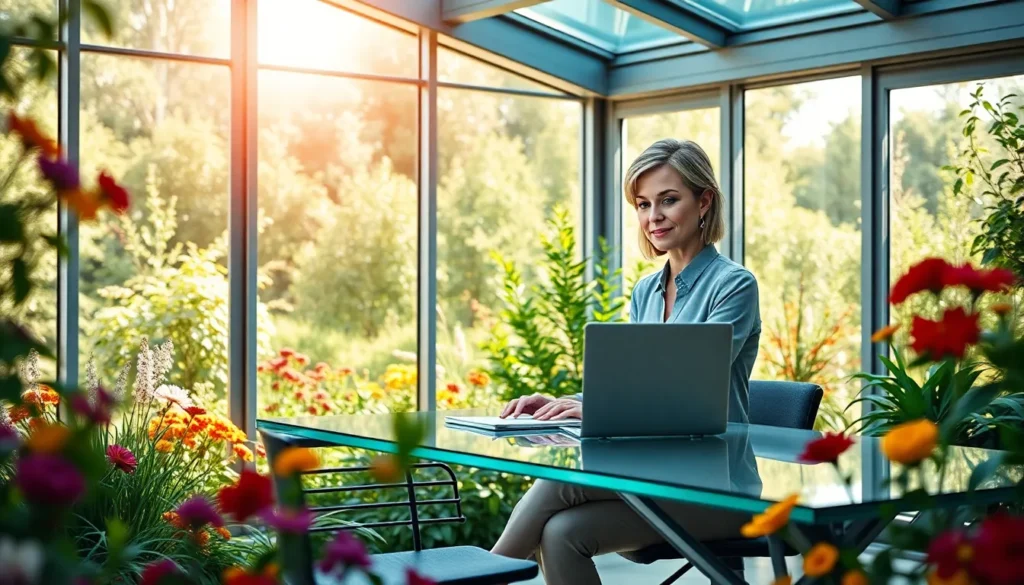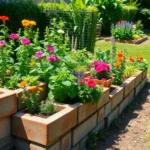Remote work has transformed how we approach our home office spaces, and we’re seeing more professionals turn to their backyards for the perfect work-from-home solution. Garden offices offer an incredible opportunity to create a dedicated workspace that’s separate from your main home while maintaining the convenience of working on your property.
We’ve discovered that these outdoor office spaces aren’t just trendy – they’re practical answers that boost productivity and provide the work-life balance we all crave. From converted sheds to custom-built studios, garden offices come in countless styles and configurations to match your exact needs and budget.
Whether you’re dealing with limited indoor space, noisy household distractions, or simply want to enjoy nature while you work, we’ll explore creative garden office ideas that’ll inspire your next home improvement project. These spaces offer the perfect blend of professional functionality and personal retreat that today’s remote workers desperately need.
Transform Your Backyard Into a Professional Workspace With These Garden Office Ideas
Planning Your Garden Office Layout
Position your garden office strategically to maximize natural light while ensuring privacy from neighbors. We recommend placing the structure at least 10 feet from your main house to create a clear psychological boundary between work and home life. Consider the sun’s path throughout the day when selecting your location, as southern exposure provides consistent lighting for most work tasks.
Survey your existing industry before breaking ground on any garden office project. Trees, slopes, and drainage patterns will influence both your design choices and construction costs. We’ve found that working with your yard’s natural features rather than against them typically saves 20-30% on installation expenses.
Factor in utility access when determining your office placement. Running electricity, internet, and plumbing to distant corners of your property can add $2,000-$5,000 to your total project budget. Positioning your workspace within 50 feet of existing utility lines keeps costs manageable while ensuring reliable connections.
Choosing the Right Garden Office Style
Modern minimalist designs feature clean lines, large windows, and neutral color palettes that blend seamlessly with contemporary landscaping. These structures typically use materials like steel framing, fiber cement siding, and floor-to-ceiling glass panels to create an airy, professional atmosphere.
Rustic cabin styles incorporate natural wood siding, stone accents, and traditional roofing materials that complement established gardens and mature trees. We’ve seen homeowners successfully use cedar shakes, reclaimed barn wood, and copper guttering to achieve this timeless aesthetic.
Contemporary cube structures maximize interior space through geometric shapes and innovative storage answers. These designs often feature flat or shed roofs, composite materials, and bold color schemes that make striking architectural statements in backyard settings.
Converted greenhouse offices repurpose existing garden structures into unique workspaces filled with natural light and growing plants. This approach works particularly well for creative professionals who find inspiration in green environments and seasonal changes.
Essential Features for Professional Garden Offices
High-speed internet connectivity forms the foundation of any successful garden office setup. We recommend installing dedicated ethernet cables or mesh network extenders to ensure upload speeds of at least 10 Mbps for video conferencing and file sharing.
Climate control systems maintain comfortable working temperatures year-round without breaking your energy budget. Mini-split heat pumps offer efficient heating and cooling for spaces under 400 square feet, while larger offices may require ducted HVAC systems.
Adequate electrical infrastructure supports modern work equipment and lighting needs. Most garden offices require 100-amp service panels with multiple GFCI outlets, USB charging stations, and surge protection for sensitive electronics.
Professional lighting answers combine task lighting, ambient illumination, and natural daylight to reduce eye strain during long work sessions. We suggest installing adjustable LED fixtures, under-cabinet strips, and dimmer switches to create versatile lighting scenarios.
Budget-Friendly Garden Office Answers
DIY shed conversions transform basic storage buildings into functional workspaces for under $5,000. These projects typically involve adding insulation, electrical wiring, interior walls, and professional flooring to create comfortable office environments.
Prefabricated office pods arrive ready for installation and can be operational within days of delivery. Prices range from $15,000-$40,000 depending on size and features, making them cost-effective alternatives to custom construction.
Container office modifications repurpose shipping containers into unique workspaces with industrial aesthetics. Standard 20-foot containers provide 160 square feet of interior space and cost approximately $25,000-$35,000 when fully converted.
Outdoor office kits include all necessary materials and instructions for weekend construction projects. These packages typically cost $8,000-$20,000 and can be assembled by homeowners with basic carpentry skills.
Maximizing Productivity in Your Garden Office
Separate work zones within your garden office help maintain focus and organization throughout busy workdays. We recommend creating distinct areas for computer work, phone calls, storage, and relaxation to optimize your daily workflow.
Ergonomic furniture selection prevents physical strain and maintains energy levels during extended work sessions. Invest in adjustable desks, supportive chairs, and proper monitor positioning to create a healthy work environment.
Natural elements integration reduces stress and improves mental clarity through biophilic design principles. Adding plants, water features, or natural materials creates calming environments that enhance creativity and problem-solving abilities.
Soundproofing measures ensure privacy for important calls while minimizing distractions from outdoor activities. Acoustic panels, double-glazed windows, and weatherstripping around doors effectively contain sound within your workspace.
Choose the Perfect Location for Your Garden Office
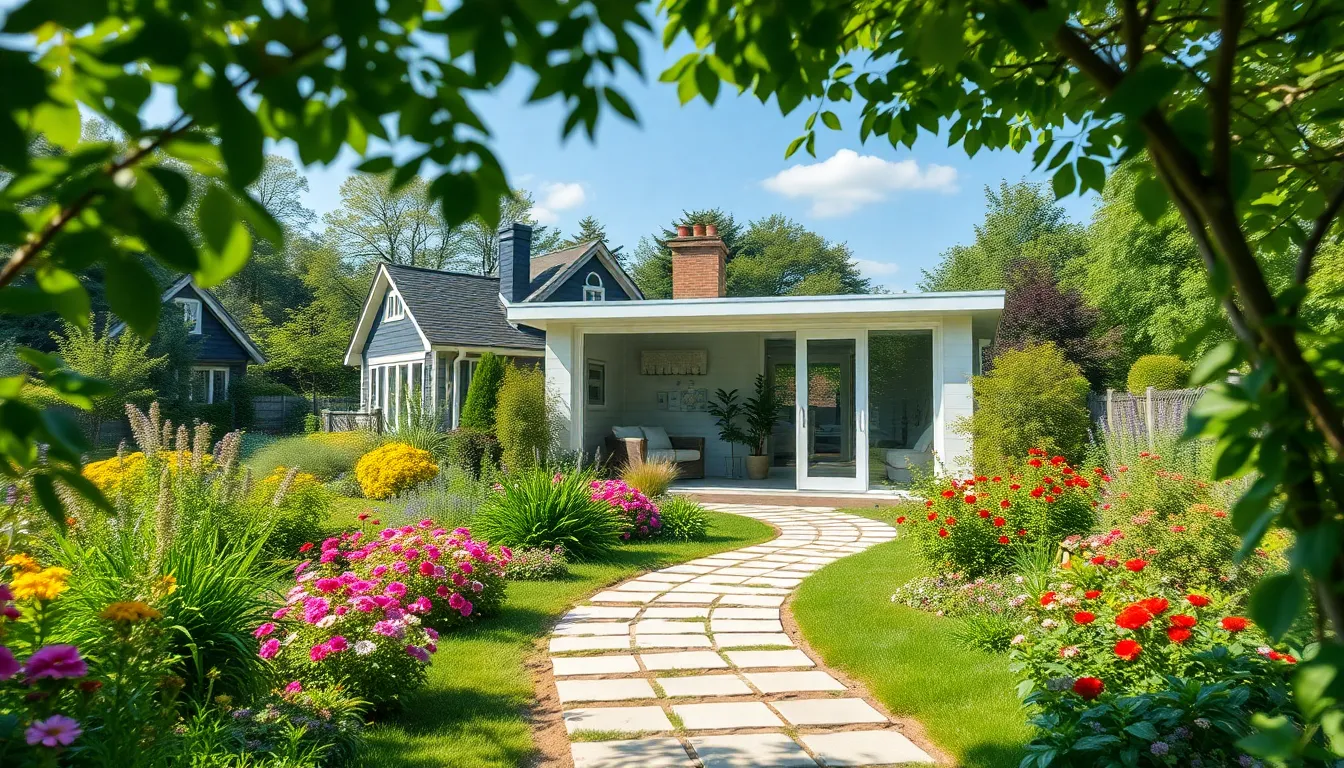
Sunlight exposure plays a crucial role in creating an energizing workspace that reduces your reliance on artificial lighting. We recommend selecting a spot that receives natural light throughout most of the day, as this can boost productivity and reduce energy costs significantly.
Accessibility from your main house should be your next priority when evaluating potential locations. Consider how you’ll navigate to your garden office during different weather conditions, especially during winter months or rainy seasons.
Noise reduction becomes essential if you plan to take client calls or conduct video meetings regularly. Position your garden office away from busy roads, neighboring properties with high activity, or areas where children frequently play.
Ground stability and drainage directly impact the longevity of your garden office structure. We suggest avoiding low lying areas where water tends to collect after rainfall, as poor drainage can lead to foundation issues over time.
Utility access for electricity, internet, and potentially plumbing should influence your location decision early in the planning process. Running cables and pipes over long distances can significantly increase installation costs and complexity.
Privacy considerations help maintain professional boundaries between your work and personal life. Natural barriers like existing trees, fences, or landscaping features can provide visual separation from your main living areas.
View optimization enhances your daily work experience by providing visual interest and connection to nature. We recommend positioning your office to take advantage of your garden’s most attractive features while avoiding direct views into neighboring properties.
Future garden plans should factor into your location choice to prevent conflicts with landscaping projects or garden expansions you might undertake later. Consider how your garden office placement will complement rather than restrict your outdoor space’s potential evolution.
Select the Right Size and Style for Your Outdoor Office Space
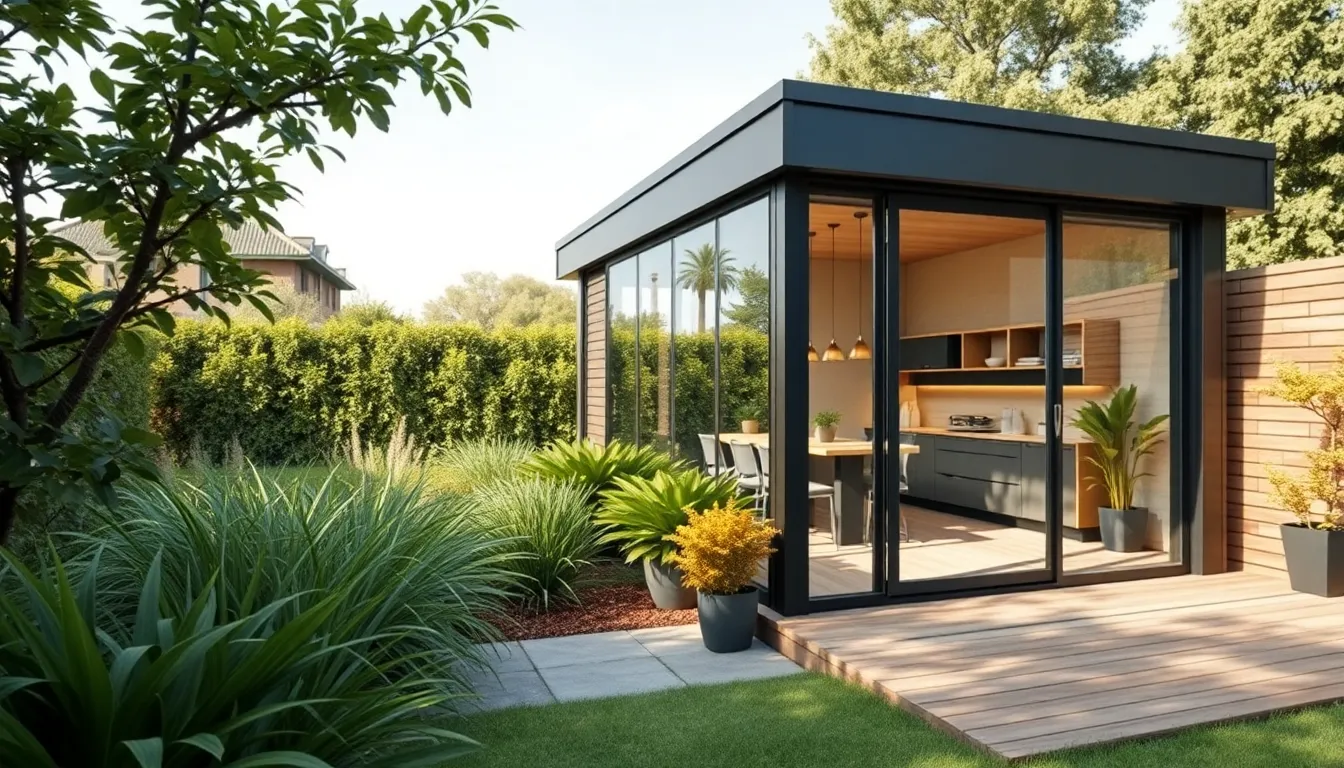
Once you’ve determined the ideal location and features for your workspace, we need to focus on selecting dimensions and design elements that align with your exact needs. The right combination of size and style will transform your garden office from a simple structure into a highly functional professional environment.
Consider Your Space Requirements and Budget
Space requirements and budget considerations form the foundation of every successful garden office project. Compact garden office pods offer budget-friendly alternatives to traditional home extensions and can be easily customized to fit tight spaces and modest budgets.
Small garden offices work exceptionally well when created using prefabricated pods or converted sheds, providing cost-effective answers for solo entrepreneurs and freelancers. Multi-functional designs serve dual purposes as both offices and storage areas, maximizing your investment for larger available spaces.
Converted garden sheds represent one of the most economical approaches, allowing you to repurpose existing structures while maintaining functionality. These transformations typically cost 60-70% less than building from scratch, making professional workspace goals achievable on tighter budgets.
Budget allocation should account for essential utilities, insulation, and interior finishing costs beyond the basic structure price. Planning for electrical work, internet connectivity, and climate control ensures your space remains functional year-round without surprise expenses.
Match Your Garden Office Design to Your Home’s Architecture
Design harmony between your garden office and home architecture creates visual cohesion that enhances your property’s overall appeal. Similar materials and design elements, such as matching roof styles or complementary colors, establish seamless integration with your existing industry.
Modern glass-walled offices provide sleek aesthetics while maintaining connection with nature, particularly effective when your main home features contemporary design elements. Traditional homes benefit from garden offices incorporating similar siding materials, window styles, and roofing materials that echo the main structure.
Color coordination extends beyond simple matching to include complementary palette choices that enhance both structures. Neutral tones like gray, beige, or natural wood finishes offer versatility while maintaining professional appearance standards.
Architectural details such as trim work, door styles, and window proportions should reflect your home’s character without creating an exact replica. Subtle design echoes maintain harmony while allowing your garden office to serve as a distinct workspace environment.
Evaluate Insulation and Weather Resistance Options
Insulation and weather resistance determine your garden office’s year-round functionality and comfort levels. Insulated office cabins provide essential warmth and comfort in colder climates, ensuring productive work sessions regardless of seasonal temperature fluctuations.
Weather-resistant materials like metal siding or durable wood finishes withstand various weather conditions while maintaining structural integrity over time. These material choices reduce maintenance requirements and protect your investment from environmental damage.
Effective insulation systems include wall, floor, and ceiling components that work together to maintain consistent interior temperatures. Proper insulation reduces heating and cooling costs while creating comfortable working conditions throughout all seasons.
Vapor barriers and moisture control systems prevent condensation issues that could damage equipment or create unhealthy working environments. Quality weatherstripping around doors and windows eliminates drafts and maintains energy efficiency standards.
Solar-powered office systems offer sustainable energy answers that reduce environmental impact while providing reliable power for essential equipment and lighting needs.
Explore Different Garden Office Construction Types
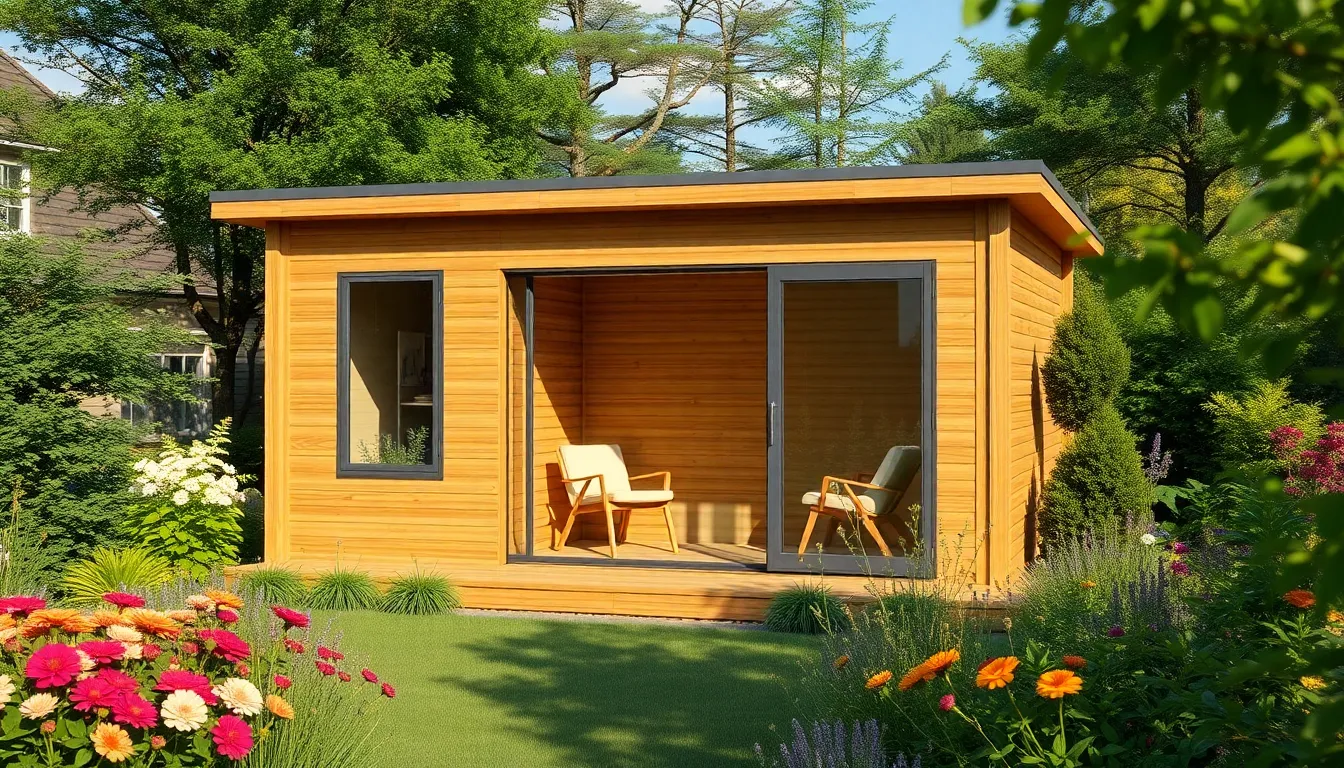
Building on our previous discussions about location and design, we’ll now examine the three primary construction approaches that transform garden office concepts into reality.
Prefabricated Garden Office Kits
Prefabricated kits revolutionize the garden office building process through modern manufacturing techniques like Structural Insulated Panels (SIPs) and timber frame construction. These off-site manufactured units arrive ready for rapid assembly in your garden space.
Key advantages of prefab garden offices include:
- Faster build times compared to traditional construction methods
- Consistent quality through controlled manufacturing environments
- Superior insulation often exceeding traditional shed standards
- House-quality thermal performance especially with SIPs construction
SIPs construction delivers exceptional structural integrity while maintaining energy efficiency throughout the year. We’ve observed that these systems provide thermal performance comparable to residential construction standards.
Custom-Built Garden Office Structures
Custom-built garden offices offer unlimited design possibilities customized to your exact specifications and space requirements. These bespoke structures accommodate unique shapes like L-shaped configurations or multifunctional spaces combining work with leisure activities.
Construction options for custom builds include:
- Traditional timber frames for classic aesthetic appeal
- Hybrid SIPs construction combining efficiency with customization
- Steel frame systems for contemporary architectural designs
- Mixed material approaches integrating glass, metal, and wood
Custom structures match the quality and durability of small residential buildings. We can incorporate high-end finishes and bespoke interior answers that reflect your professional needs and personal style preferences.
Converted Garden Sheds and Outbuildings
Converting existing garden sheds presents the most economical path to creating your garden office workspace. This approach transforms underutilized structures through strategic upgrades to insulation, electrical systems, and interior finishes.
Essential conversion requirements include:
- Upgraded insulation to ensure year-round comfort
- Professional electrical wiring for safe power distribution
- Interior finishing to create professional workspace standards
- Climate control systems for temperature regulation
Shed conversions work ideally for budget-conscious homeowners seeking quick workspace answers. But, these projects often require important modifications to achieve the comfort and usability standards expected in professional garden offices.
Design Your Garden Office Interior for Maximum Productivity
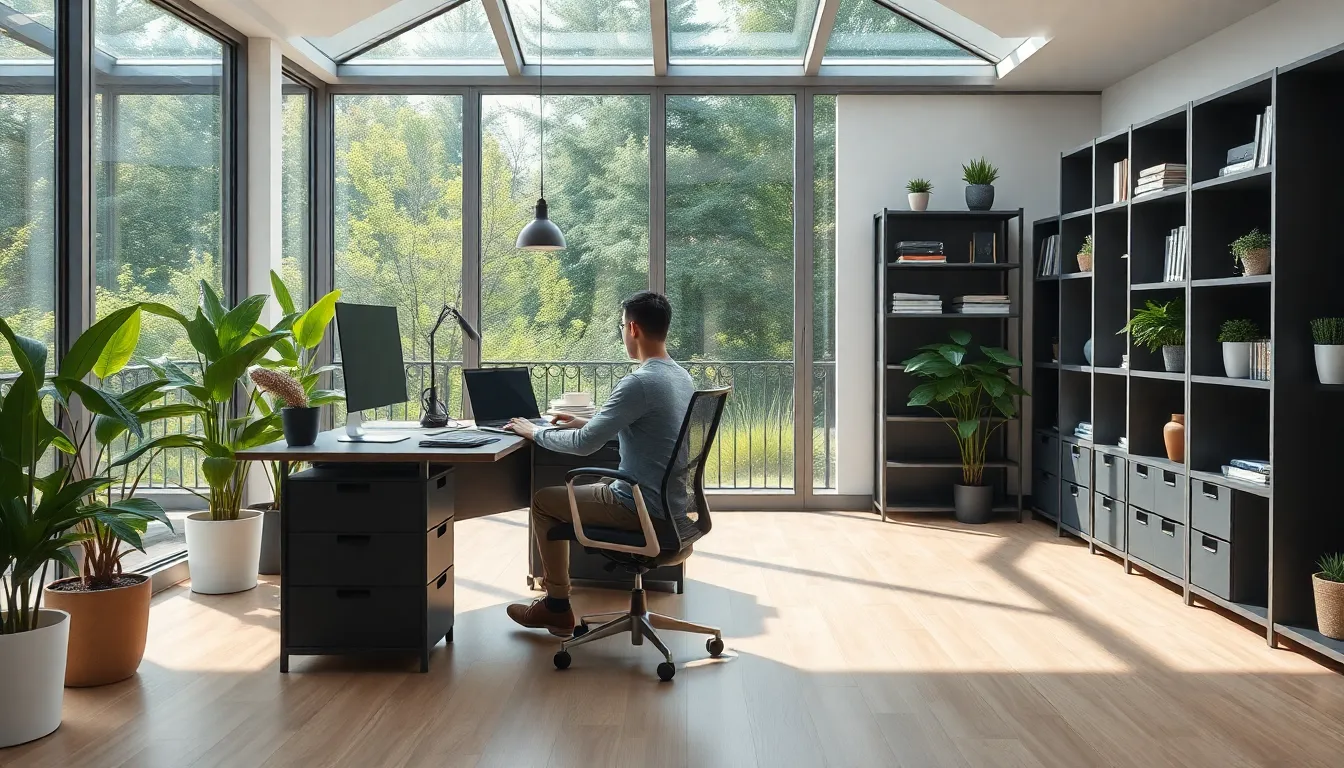
Interior design directly impacts your productivity levels in a garden office setting. We’ll explore key strategies to create a workspace that enhances focus and efficiency throughout your workday.
Create an Ergonomic Workspace Layout
Multiple desks for collaboration create separate zones for focus and group discussions, maximizing your garden office’s functionality. Positioning workstations strategically allows you to accommodate different work styles and activities within the same space.
Modular furniture answers help you maximize space without compromising comfort. We recommend foldable desks that adapt to your daily needs, transforming from spacious work surfaces to compact storage when not in use.
Hybrid spaces integrate multiple functions seamlessly into your garden office design. Consider incorporating a gym area with foldable desks and discreet storage for gym equipment, creating a wellness focused workspace that supports both physical and mental productivity.
Traffic flow patterns should guide your furniture placement decisions. Position desks away from high traffic areas while maintaining clear pathways between different zones in your garden office.
Choose Appropriate Lighting Answers
Natural light maximization forms the foundation of effective garden office lighting. Ample windows and skylights reduce eye strain while creating an energizing atmosphere that connects you with the outdoor environment.
Task lighting provides focused illumination for exact workstations and activities. We suggest adjustable desk lamps and under cabinet lighting to supplement natural light during early morning or evening work sessions.
Layered lighting systems combine ambient, task, and accent lighting to create versatile illumination options. This approach allows you to adjust lighting levels based on different work activities throughout the day.
Light positioning prevents screen glare and shadows on your workspace. Position your monitor perpendicular to windows and use adjustable blinds to control natural light intensity when needed.
Select Comfortable and Functional Furniture
Ergonomic chairs support prolonged sitting sessions and prevent workplace injuries. Choose chairs with adjustable height, lumbar support, and armrests that accommodate your exact body measurements and work habits.
Smart storage answers maintain a clutter free environment essential for productivity. Incorporate clever storage options like built in shelving, under desk drawers, and wall mounted organizers to keep supplies organized and easily accessible.
Adjustable height desks accommodate different work preferences and health needs. We recommend sit stand desks that allow you to alternate between sitting and standing positions throughout your workday.
Multi functional furniture pieces maximize your garden office’s limited square footage. Ottoman storage seats, expandable desks, and convertible surfaces serve multiple purposes while maintaining a clean aesthetic.
Quality materials ensure your furniture investment lasts through years of daily use. Select pieces made from durable woods, metals, and fabrics that withstand the unique environmental conditions of a garden office setting.
Install Essential Utilities and Technology
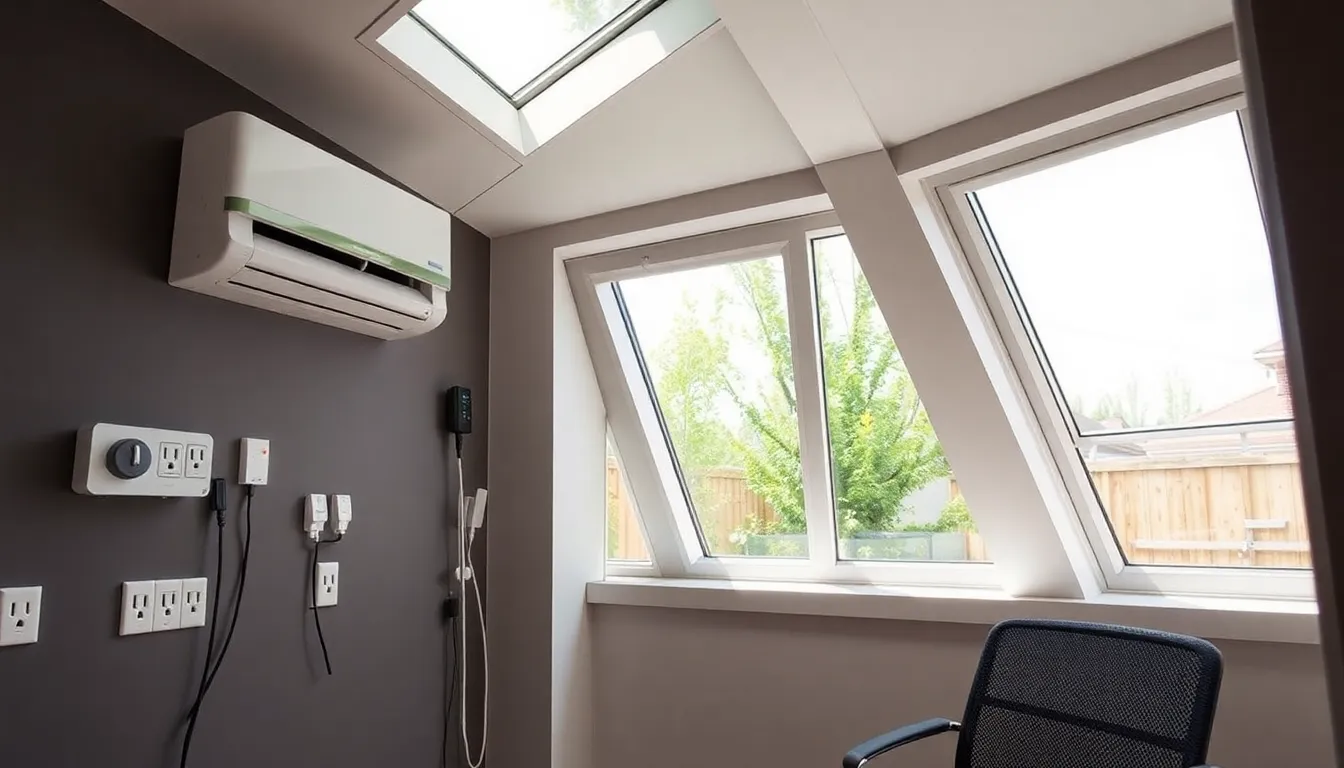
We’ve covered design and construction fundamentals, but now we need to focus on the technical infrastructure that transforms your garden office from a beautiful structure into a fully functional workspace. Installing reliable utilities and technology ensures your outdoor office operates smoothly year-round while supporting all your professional activities.
Plan Your Electrical and Internet Connections
Professional electrical installation forms the foundation of any productive garden office, powering everything from lighting systems to computer equipment safely and efficiently. We recommend hiring qualified electricians to install dedicated circuits that can handle multiple devices simultaneously, including printers, monitors, and charging stations without overloading the system.
Waterproof outlets and weather-resistant electrical components protect your investment from moisture damage while ensuring consistent power delivery throughout changing seasons. Planning for adequate socket placement eliminates the need for extension cords and creates a cleaner, safer workspace environment.
Internet connectivity requires careful consideration of distance from your main house and potential signal interference from garden features or neighboring structures. Wired Ethernet cables provide the most reliable connection for video conferencing and large file transfers, while high-quality Wi-Fi extenders offer flexibility for wireless devices and mobile work arrangements.
Concealed cable management keeps your garden office looking professional while protecting electrical and internet lines from weather exposure and potential damage. Strategic routing through underground conduits or wall-mounted channels maintains both safety standards and aesthetic appeal.
Consider Heating and Cooling Options
Temperature control systems ensure comfortable working conditions regardless of seasonal weather changes, making your garden office usable throughout the entire year. Electric radiators provide consistent, controllable heating that can be zoned for exact areas of your workspace, while underfloor heating offers efficient warmth distribution without taking up wall space.
Compact air conditioning units handle both heating and cooling needs through heat pump technology, offering energy-efficient climate control in a single system. Portable air conditioners work well for smaller garden offices or situations where permanent installation isn’t feasible.
Ceiling fans create air circulation that makes warm weather more comfortable while reducing energy costs compared to continuous air conditioning use. Cross ventilation strategies using strategically placed windows can naturally cool your space during mild weather conditions.
Insulation upgrades significantly improve the efficiency of any heating or cooling system by reducing energy loss through walls, floors, and ceilings. Quality insulation materials pay for themselves through lower utility bills and more consistent indoor temperatures.
Set Up Proper Ventilation Systems
Adequate air circulation prevents moisture buildup that can damage equipment and create uncomfortable working conditions while maintaining healthy indoor air quality. Natural ventilation through adjustable windows and skylights allows you to control airflow based on weather conditions and personal comfort preferences.
Roof vents create passive air movement that helps regulate temperature and humidity levels without requiring electricity or maintenance. These vents work particularly well in combination with lower intake vents to create consistent air circulation patterns.
Mechanical ventilation systems provide consistent air exchange rates regardless of wind conditions or outdoor temperatures, ensuring optimal air quality during sealed heating or cooling periods. Exhaust fans can be installed in areas prone to moisture accumulation, such as near coffee stations or plant displays.
Humidity control becomes especially important in garden offices where temperature fluctuations can create condensation problems that affect both comfort and equipment longevity. Combining proper ventilation with moisture monitoring helps maintain ideal working conditions year-round.
Incorporate Natural Elements and Landscaping
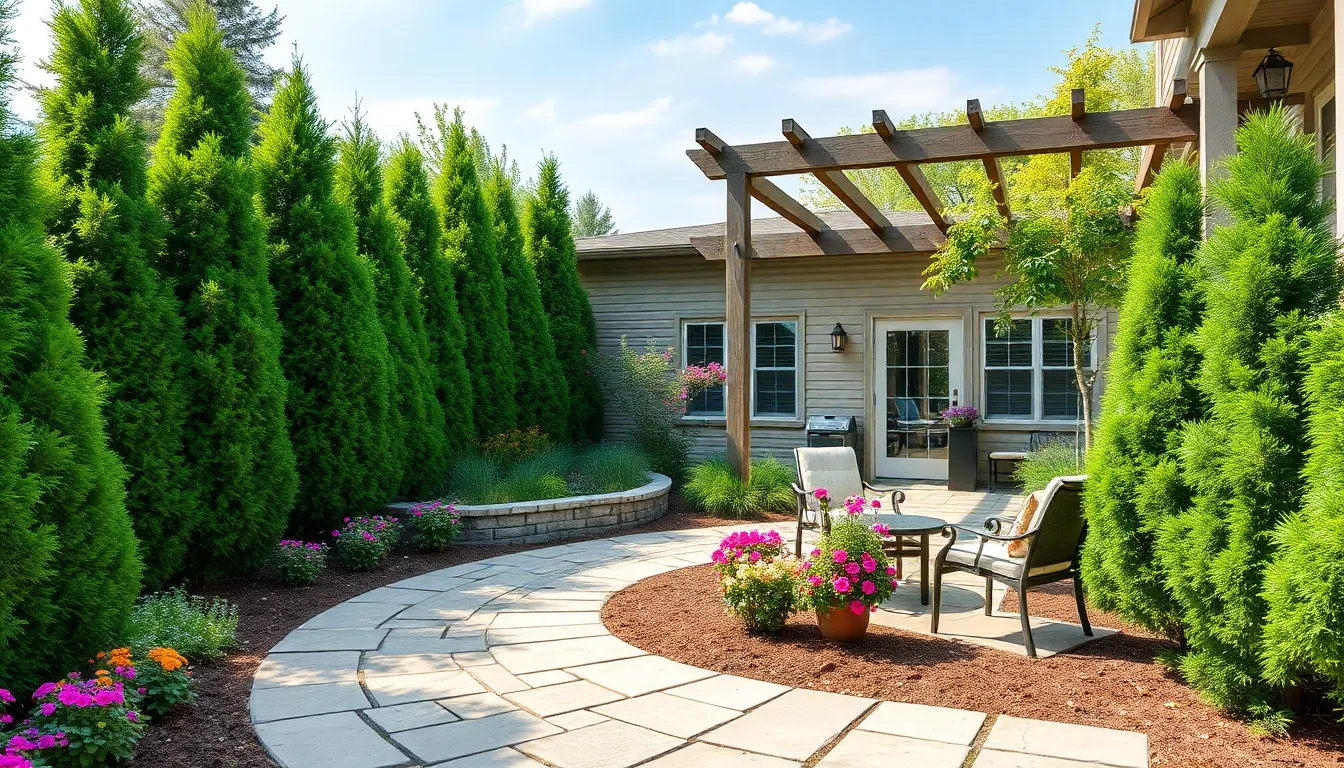
Transforming your garden office into a cohesive part of your outdoor industry creates a seamless transition between work and nature. We’ll explore how strategic landscaping choices can enhance both the functionality and aesthetic appeal of your workspace.
Surround Your Office With Privacy Plants
Screening plants create natural barriers that enhance privacy while reducing noise pollution around your garden office. Tall evergreen shrubs like laurel, bamboo, or cypress provide year-round coverage and maintain their density throughout the seasons. Strategic placement of these plants can block unwanted views from neighboring properties while creating a peaceful work environment.
Green walls offer an innovative approach to privacy screening that maximizes vertical space around your office. Living walls can be constructed using modular planting systems or climbing plants on trellis structures. These installations provide excellent sound dampening while adding oxygen to your workspace environment.
Dense hedging using native species creates effective screening that requires minimal maintenance once established. Plants like boxwood, holly, or native shrubs adapt well to local climate conditions and provide consistent coverage throughout the year.
Create Pathways and Garden Access Routes
Curving pathways guide visitors naturally from your main house to the garden office while creating visual interest in your industry design. These flowing routes prevent the garden office from appearing isolated and integrate it seamlessly into your existing garden layout.
Stone landings provide stable, weather-resistant surfaces that connect different areas of your garden workspace. Natural stone materials like flagstone or slate create durable transitions that complement both modern and traditional garden office designs.
Gravel access routes offer an economical solution for creating defined pathways that drain well in all weather conditions. Permeable gravel surfaces prevent water pooling while providing a professional appearance that requires minimal ongoing maintenance.
Stepping stones through planted areas create an captivating approach to your office while preserving garden beds and lawn areas. These elements add visual texture and help define the journey to your workspace.
Add Outdoor Seating and Break Areas
Outdoor seating areas extend your workspace beyond the confines of your garden office, providing flexible locations for phone calls, brainstorming sessions, or lunch breaks. Weather-resistant furniture like teak benches or metal bistro sets create inviting spaces that encourage outdoor time during work hours.
Common areas designed for team gatherings foster collaboration when colleagues visit your garden office for meetings. These spaces can include larger table settings or conversation areas that accommodate multiple people comfortably.
Break zones positioned strategically around your garden office provide mental respite during long work sessions. Simple seating arrangements near flowering plants or water features create calming environments that help reduce work-related stress.
Covered outdoor spaces using pergolas or shade sails extend the usability of outdoor seating areas throughout different weather conditions. These structures provide protection from sun and light rain while maintaining the outdoor experience that makes garden offices appealing.
Budget-Friendly Garden Office Ideas That Deliver Results
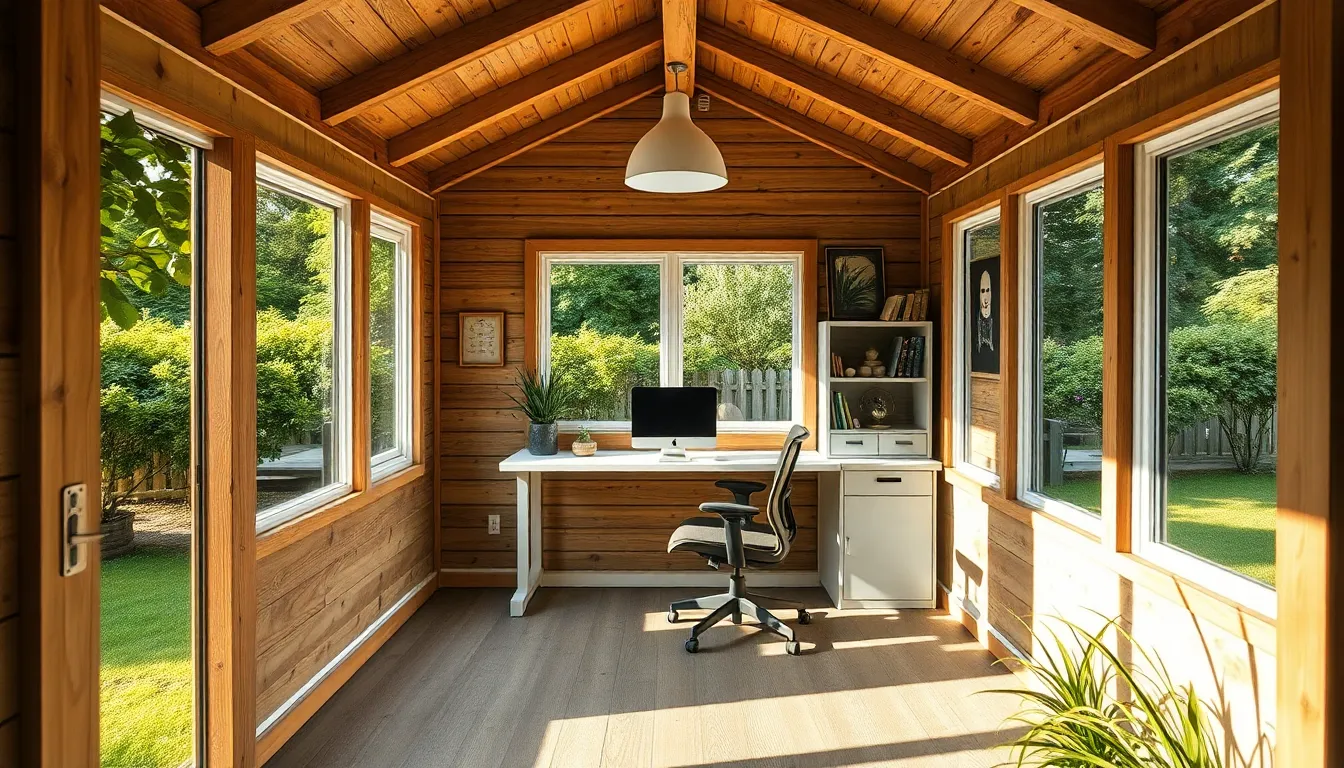
Creating a professional garden office doesn’t require a massive investment when you know the right strategies. Smart planning and creative approaches can deliver exceptional results within modest budgets.
DIY Garden Office Projects
Building your own garden office provides important cost savings while allowing complete customization to your exact needs. DIY garden rooms can be constructed for as little as £500 when focusing on simplicity and efficiency, making this approach accessible to most homeowners.
Converting an existing shed represents one of the most popular DIY projects for creating affordable workspace answers. We recommend adding windows for natural light, installing electrical connections for power needs, and incorporating proper insulation for year round comfort. These modifications transform basic storage structures into functional offices without major construction expenses.
Prefabricated garden office pods offer another excellent DIY option that combines affordability with professional appearance. These compact structures arrive as kits with detailed assembly instructions, allowing homeowners to complete installation over weekends. Pod designs typically include essential features like windows, doors, and basic electrical preparations while maintaining costs significantly below custom construction.
Self build approaches work particularly well when you possess basic construction skills and can dedicate time to the project. Planning the layout carefully before starting ensures efficient use of materials and prevents costly mistakes during construction.
Repurposing Existing Structures
Transforming existing garden structures creates functional offices while maximizing your current investments in outdoor buildings. Shed conversions represent the most cost effective approach, requiring only strategic upgrades rather than complete new construction.
Standard garden sheds convert into productive offices through systematic improvements focusing on lighting, insulation, and electrical infrastructure. We suggest installing LED lighting systems for energy efficiency, adding comfortable seating areas for meetings, and incorporating proper ventilation to maintain air quality throughout the workday.
Oak frame structures provide another repurposing opportunity for homeowners with existing timber buildings or those who can source reclaimed materials affordably. These frameworks offer natural aesthetic appeal while supporting various cladding options to match your home’s architectural style.
Greenhouse conversions work exceptionally well in mild climates where the glass structure provides abundant natural light for productive work environments. Adding insulation panels during colder months and installing proper ventilation prevents overheating during summer conditions.
Existing gazebos or pergolas can be enclosed with weather resistant materials to create semi open office spaces that blend indoor comfort with outdoor ambiance.
Affordable Interior Design Answers
Strategic interior choices maximize functionality while maintaining strict budget control throughout your garden office project. Proper lighting serves as the foundation for productive workspaces, combining natural light sources with efficient LED installations for comprehensive illumination.
Natural light optimization reduces electricity costs while improving your daily work experience through better mood and energy levels. Position desks near windows and use light colored surfaces to reflect available sunlight throughout the interior space. Task lighting additions like desk lamps and under cabinet strips provide focused illumination for detailed work without major electrical modifications.
Furniture selection impacts both comfort and budget significantly when outfitting your garden office interior. We recommend starting with a quality desk and ergonomic chair as essential investments, then adding storage answers and seating areas gradually as budget allows. Second hand office furniture often provides professional appearance at fraction of retail costs.
Color schemes using paint and decorative prints add personality and style without substantial expense. Light colors make small spaces appear larger while bold accent walls create visual interest and defined work zones. Strategic use of mirrors can further enhance the sense of space in compact garden offices.
Storage answers maximize available floor space while maintaining organized work environments essential for productivity. Wall mounted shelving, under desk drawers, and multi functional furniture pieces provide organization without cluttering the limited square footage typical in budget garden offices.
Overcome Common Garden Office Challenges
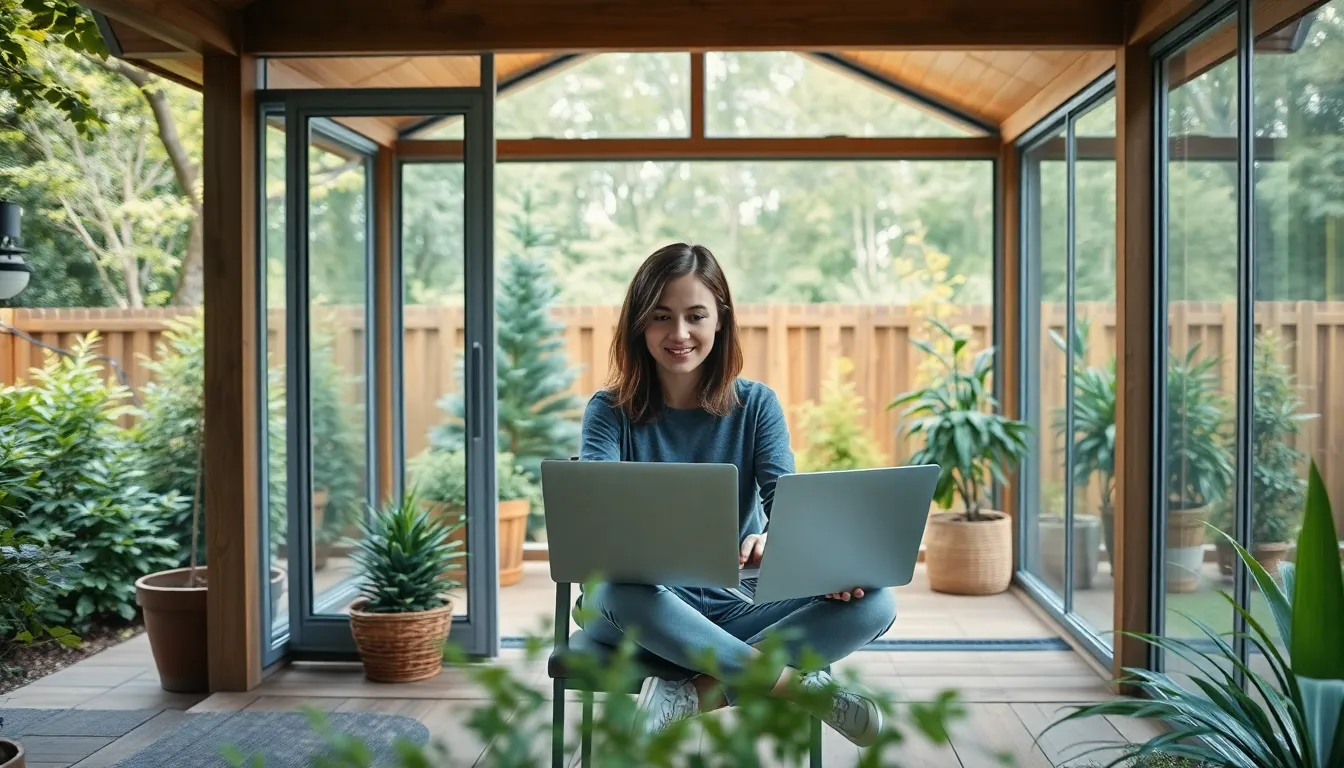
Converting your vision into a functional garden office requires handling several practical hurdles that most homeowners face. We’ll explore the most effective answers to ensure your outdoor workspace operates seamlessly year-round.
Address Planning Permission Requirements
Planning permissions become simpler when we understand the exact regulations for garden offices. Many small garden offices under certain size limits and height restrictions fall under permitted development rights in the UK, meaning planning permission may not be required. Local council rules vary significantly, so proximity to property boundaries and intended usage type can trigger permission requirements.
Verifying local regulations before construction saves time and potential legal complications. We recommend contacting your local planning authority early in the design process to clarify any restrictions. Some areas have exact guidelines about garden office placement, maximum footprint size, and height limitations that directly impact your building plans.
Documentation helps streamline the approval process if permits are necessary. Building regulations may still apply even when planning permission isn’t required, particularly for electrical work and structural modifications. Professional consultation ensures compliance with all relevant codes and standards.
Solve Connectivity and Power Issues
Reliable internet connectivity forms the foundation of any productive garden office. Extending Wi-Fi signals through mesh networks or installing dedicated broadband lines ensures consistent connection quality. We’ve found that wired Ethernet connections provide the most stable internet access for video calls and large file transfers.
Solar-powered garden offices offer sustainable electricity answers for eco-conscious homeowners. These innovative systems reduce utility costs while providing adequate power for lighting, heating, and electronic devices. Battery backup systems maintain functionality during cloudy periods or peak usage times.
Electrical infrastructure requires professional installation for safety and efficiency. Qualified electricians ensure proper wiring, circuit protection, and weatherproof connections that meet building codes. Underground cable runs protect electrical systems from weather damage and maintain your garden’s aesthetic appeal.
Manage Year-Round Comfort and Maintenance
Insulated office cabins maintain comfortable internal temperatures throughout all seasons. Effective insulation systems reduce heating and cooling costs while creating a practical workspace for both winter warmth and summer comfort. Double-glazed windows and weatherstripping prevent heat loss and drafts.
Ventilation systems prevent moisture buildup and maintain healthy air quality. Natural ventilation through strategically placed windows works well in mild weather, while mechanical ventilation fans handle extreme temperatures. Proper airflow prevents condensation issues that can damage equipment and furniture.
Regular maintenance schedules protect your investment and ensure long-term functionality. Weatherproofing treatments, gutter cleaning, and electrical system inspections prevent minor issues from becoming costly repairs. Durable flooring materials and quality construction materials reduce maintenance frequency and expenses.
Maximize Your Garden Office Investment With Smart Features
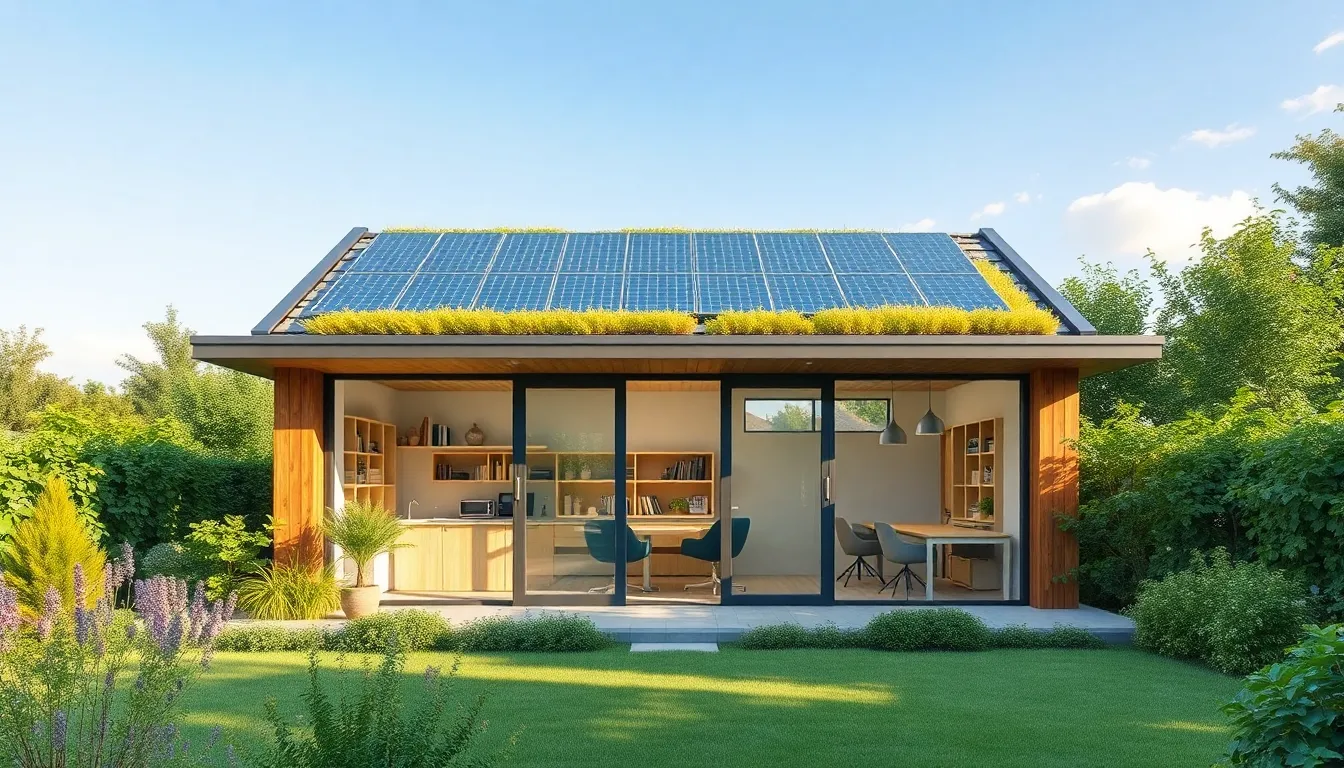
Smart garden office features transform your workspace into a high-performance environment that pays dividends over time. We’ll explore cutting-edge answers that enhance productivity while protecting your investment.
Install Energy-Efficient Answers
Solar panel systems reduce your dependency on external power sources while generating renewable energy for your garden office operations. Installing these panels on your garden office roof creates substantial long-term savings on electricity bills and increases property value.
Energy efficient insulation maintains stable temperatures year-round by minimizing heat loss during winter months and reducing cooling costs in summer. Materials like spray foam insulation or high-performance fiber batts keep your workspace comfortable while lowering energy consumption by up to 40%.
Green roof installations improve insulation performance naturally while creating wildlife habitats above your workspace. These living roofs provide additional temperature regulation and stormwater management for your property.
Rainwater harvesting systems collect and store precipitation for irrigation and non-potable water needs throughout your garden. Installing gutters, downspouts, and storage tanks transforms your garden office into an eco-friendly water conservation hub.
Add Security Systems and Storage Options
Secure doors and windows protect your valuable equipment and confidential work materials from unauthorized access. Installing multi-point locking systems and reinforced glass provides peace of mind when you’re away from your garden office.
Alarm system integration connects your garden office to your home’s security network or operates as a standalone monitoring solution. Motion sensors, door contacts, and surveillance cameras create comprehensive protection for your remote workspace.
Hidden storage answers maintain a clutter-free environment while maximizing your available floor space. Built-in cabinets, under-desk drawers, and wall-mounted organizers keep essential supplies accessible but out of sight.
Open shelving systems display reference materials and personal items while maintaining easy access to frequently used resources. Floating shelves and modular units adapt to changing storage needs as your business grows.
Plan for Future Expansion Needs
Open plan layouts accommodate future workspace changes without requiring major structural modifications. Designing flexible floor plans allows you to reconfigure furniture arrangements and add equipment as your business evolves.
Modular furniture systems adapt to different activities and collaboration needs while supporting easy rearrangement. Pieces that serve multiple functions, like storage ottomans or folding desks, maximize space efficiency in compact garden offices.
Flexible work zones create dedicated areas for focused work, collaborative meetings, and creative activities within your garden office. Establishing quiet zones alongside collaborative spaces supports diverse work styles and project requirements.
Technology integration areas prepare your space for smart boards, video conferencing equipment, and emerging workplace technologies. Pre-wiring electrical outlets and data connections in strategic locations prevents costly retrofitting later.
Personal touches like artwork and plants create a welcoming environment that reflects your professional brand while supporting well-being. Biophilic design elements, including large glass doors and floor-to-ceiling windows, connect your workspace to nature and enhance productivity through natural light exposure.
Conclusion
Creating your perfect garden office represents an investment in both your professional success and personal well-being. We’ve explored countless possibilities—from budget-friendly DIY conversions to sophisticated custom builds—proving that every homeowner can find a solution that fits their needs and budget.
The key lies in thoughtful planning that balances functionality with aesthetics. Whether you’re converting an existing shed or building from scratch your garden office should seamlessly integrate with your outdoor space while providing the professional environment you need to thrive.
Your garden office journey doesn’t end with construction. Smart features sustainable answers and personal touches will continue improving your workspace long after you’ve settled in. With proper planning and creativity you’ll transform not just how you work but how you experience the balance between your professional and personal life.
Frequently Asked Questions
What is a garden office and why are they becoming popular?
A garden office is a dedicated workspace built in your backyard, separate from your main home. They’ve gained popularity due to the rise in remote work, offering professionals a quiet, productive environment while maintaining work-life balance. These outdoor offices eliminate home distractions and create a professional atmosphere without the need for expensive commercial office space.
How much does it cost to build a garden office?
Garden office costs vary significantly based on size, materials, and features. DIY conversions can start from £500, while prefabricated pods range from £3,000-£15,000. Custom-built structures typically cost £10,000-£50,000 or more. Budget-friendly options include converting existing sheds, using prefabricated kits, or repurposing shipping containers to reduce overall expenses.
Do I need planning permission for a garden office?
Many small garden offices fall under permitted development rights and don’t require planning permission. However, restrictions apply regarding size, height, proximity to boundaries, and whether your property is in a conservation area. Always check with your local planning authority early in the design process to avoid potential issues.
What’s the best location for a garden office in my yard?
Choose a location with good natural light, preferably facing south or southeast for optimal sunlight exposure. Consider accessibility from your main house, privacy from neighbors, ground stability for the foundation, and proximity to utilities like electricity and internet. Ensure adequate drainage and think about future garden plans.
How do I ensure my garden office is comfortable year-round?
Install proper insulation in walls, floors, and ceiling to maintain temperature. Add heating solutions like electric radiators or heat pumps, and cooling options such as air conditioning or ceiling fans. Ensure adequate ventilation to prevent moisture buildup and maintain air quality. Weather-resistant materials are essential for durability.
What utilities do I need to install in my garden office?
Essential utilities include reliable electricity installed by a qualified electrician, high-speed internet connection (preferably wired Ethernet), heating and cooling systems, and proper lighting. Consider water access if needed for facilities. Solar panels can provide sustainable energy, while battery backup systems ensure uninterrupted power during outages.
Can I convert an existing garden shed into an office?
Yes, converting an existing shed is a cost-effective option. Key upgrades include adding proper insulation, installing windows for natural light, upgrading electrical systems, improving ventilation, and reinforcing the structure if necessary. Ensure the foundation is stable and weatherproof the exterior to create a professional, comfortable workspace.
What interior design features make a garden office productive?
Focus on ergonomic furniture including adjustable desks and supportive chairs, adequate lighting with natural light supplemented by task lighting, organized storage solutions to minimize clutter, and proper ventilation. Incorporate plants and natural elements to improve air quality and well-being while maintaining a professional atmosphere.
How can I make my garden office more secure?
Install quality locks on doors and windows, consider alarm systems connected to your home security, use reinforced doors and window security film, add motion-sensor lighting around the perimeter, and consider CCTV cameras. Ensure valuable equipment isn’t visible from outside and establish clear sight lines from your main house.
What are some eco-friendly features I can add to my garden office?
Consider solar panels for renewable energy, rainwater harvesting systems, green roofs for insulation and temperature regulation, energy-efficient LED lighting, sustainable building materials like reclaimed wood, and proper insulation to reduce energy consumption. These features reduce environmental impact while potentially lowering operating costs long-term.

